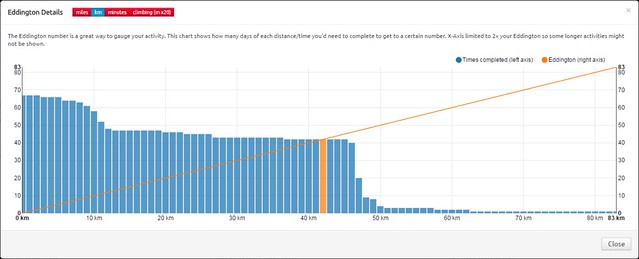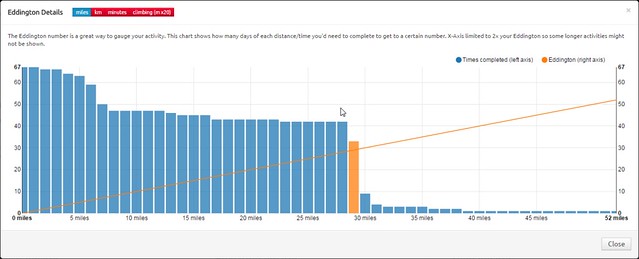Eddington Number
Eddington Number
I’m a keen user of Veloviewer as it provides some excellent methods of viewing my Strava data in a way that Strava can or does not provide, whilst adding on additional statistics.
I like it enough that I pay for the premium version (£10 a year) and I feel tha this is money well spent. Whilst I’ve said before that cycling isn’t all about the numbers, I do find myself as an engineer enjoying looking at the figures as well!
Eddington Number
Veloviewer is able to calculate and display a cyclists Eddington Number.
The Eddington number in the context of cycling is defined as the maximum number E such that the cyclist has cycled E miles on E days. For example, an Eddington number of 70 would imply that the cyclist has cycled at least 70 miles in a day on 70 occasions.
The Eddington number has units - so it can be measured in either miles, km, or whatever distance you measure your cycling (or running, walking or any other distance sport - any can have an Eddington number). And your Eddington number in one distance is not directly compatible with the other distance. For example, Veloviewer shows the Eddington in miles and in km. My overall values are 36 miles and 51 km - this means that I’ve cycled at least 36 miles in a day on 36 days and 51 km on at least 51 days. Converting the miles into kilometers shows 57.6, whereas my Eddington number is actually less! So the Eddington number is entirely different for the different measurement values.
Veloviewer have a nice blog post trying to explain it here.
Personal Eddington Numbers
Looking at Veloviewer, as I’ve said, I’ve got an overall Eddington score of the following:
36 ml and 51 km
Looking at 2016 however, the results are a bit lower…
29 ml and 42 km
And the graph could indicate why this is the case:
though in miles, the drop off after 29 is more noticable
The majority of my cyclcing last year was commuting - this is obviously a fairly set distance! I can’t move my house any further away from work (though I could Cycle a different route and therefore, distance). These commutes are clearly seen in the graphs, with a sharp decline after 29 miles!
Why am I discussing this?
Well it would be nice this year to increase my Eddington number above last years distances. That means 30 days of 30 miles or more, or 42 days of 42km or more so it gives me some ideas to aim for. I’m not sure I’d manage to make it much higher, but it’ll be worth a shot. It provides an incentive to get out at the weekend on the bike as well. I’ve applied for a place on Ride London this year again so I’m hoping that I’ll be able to get my place on that and then my training rides would certainly help me to increase my Eddington number I expect!

